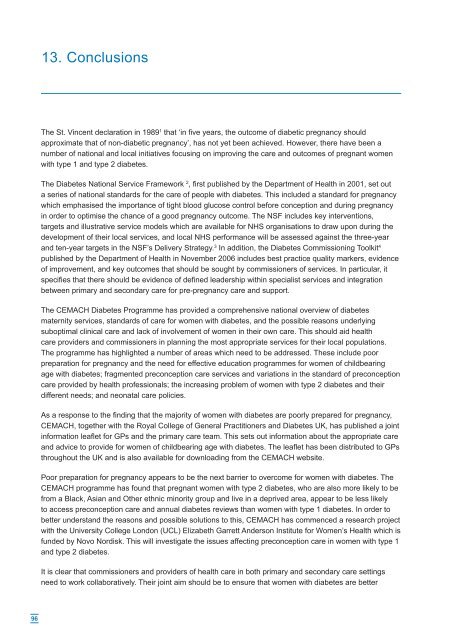Diabetes in pregnancy: are we providing the best care ... - HQIP
Diabetes in pregnancy: are we providing the best care ... - HQIP
Diabetes in pregnancy: are we providing the best care ... - HQIP
Create successful ePaper yourself
Turn your PDF publications into a flip-book with our unique Google optimized e-Paper software.
13. Conclusions<br />
The St. V<strong>in</strong>cent declaration <strong>in</strong> 1989 1 that ‘<strong>in</strong> fi ve years, <strong>the</strong> outcome of diabetic <strong>pregnancy</strong> should<br />
approximate that of non-diabetic <strong>pregnancy</strong>’, has not yet been achieved. Ho<strong>we</strong>ver, <strong>the</strong>re have been a<br />
number of national and local <strong>in</strong>itiatives focus<strong>in</strong>g on improv<strong>in</strong>g <strong>the</strong> c<strong>are</strong> and outcomes of pregnant women<br />
with type 1 and type 2 diabetes.<br />
The <strong>Diabetes</strong> National Service Framework 2 , fi rst published by <strong>the</strong> Department of Health <strong>in</strong> 2001, set out<br />
a series of national standards for <strong>the</strong> c<strong>are</strong> of people with diabetes. This <strong>in</strong>cluded a standard for <strong>pregnancy</strong><br />
which emphasised <strong>the</strong> importance of tight blood glucose control before conception and dur<strong>in</strong>g <strong>pregnancy</strong><br />
<strong>in</strong> order to optimise <strong>the</strong> chance of a good <strong>pregnancy</strong> outcome. The NSF <strong>in</strong>cludes key <strong>in</strong>terventions,<br />
targets and illustrative service models which <strong>are</strong> available for NHS organisations to draw upon dur<strong>in</strong>g <strong>the</strong><br />
development of <strong>the</strong>ir local services, and local NHS performance will be assessed aga<strong>in</strong>st <strong>the</strong> three-year<br />
and ten-year targets <strong>in</strong> <strong>the</strong> NSF’s Delivery Strategy. 3 In addition, <strong>the</strong> <strong>Diabetes</strong> Commission<strong>in</strong>g Toolkit 4<br />
published by <strong>the</strong> Department of Health <strong>in</strong> November 2006 <strong>in</strong>cludes <strong>best</strong> practice quality markers, evidence<br />
of improvement, and key outcomes that should be sought by commissioners of services. In particular, it<br />
specifi es that <strong>the</strong>re should be evidence of defi ned leadership with<strong>in</strong> specialist services and <strong>in</strong>tegration<br />
bet<strong>we</strong>en primary and secondary c<strong>are</strong> for pre-<strong>pregnancy</strong> c<strong>are</strong> and support.<br />
The CEMACH <strong>Diabetes</strong> Programme has provided a comprehensive national overview of diabetes<br />
maternity services, standards of c<strong>are</strong> for women with diabetes, and <strong>the</strong> possible reasons underly<strong>in</strong>g<br />
suboptimal cl<strong>in</strong>ical c<strong>are</strong> and lack of <strong>in</strong>volvement of women <strong>in</strong> <strong>the</strong>ir own c<strong>are</strong>. This should aid health<br />
c<strong>are</strong> providers and commissioners <strong>in</strong> plann<strong>in</strong>g <strong>the</strong> most appropriate services for <strong>the</strong>ir local populations.<br />
The programme has highlighted a number of <strong>are</strong>as which need to be addressed. These <strong>in</strong>clude poor<br />
preparation for <strong>pregnancy</strong> and <strong>the</strong> need for effective education programmes for women of childbear<strong>in</strong>g<br />
age with diabetes; fragmented preconception c<strong>are</strong> services and variations <strong>in</strong> <strong>the</strong> standard of preconception<br />
c<strong>are</strong> provided by health professionals; <strong>the</strong> <strong>in</strong>creas<strong>in</strong>g problem of women with type 2 diabetes and <strong>the</strong>ir<br />
different needs; and neonatal c<strong>are</strong> policies.<br />
As a response to <strong>the</strong> fi nd<strong>in</strong>g that <strong>the</strong> majority of women with diabetes <strong>are</strong> poorly prep<strong>are</strong>d for <strong>pregnancy</strong>,<br />
CEMACH, toge<strong>the</strong>r with <strong>the</strong> Royal College of General Practitioners and <strong>Diabetes</strong> UK, has published a jo<strong>in</strong>t<br />
<strong>in</strong>formation leafl et for GPs and <strong>the</strong> primary c<strong>are</strong> team. This sets out <strong>in</strong>formation about <strong>the</strong> appropriate c<strong>are</strong><br />
and advice to provide for women of childbear<strong>in</strong>g age with diabetes. The leafl et has been distributed to GPs<br />
throughout <strong>the</strong> UK and is also available for download<strong>in</strong>g from <strong>the</strong> CEMACH <strong>we</strong>bsite.<br />
Poor preparation for <strong>pregnancy</strong> appears to be <strong>the</strong> next barrier to overcome for women with diabetes. The<br />
CEMACH programme has found that pregnant women with type 2 diabetes, who <strong>are</strong> also more likely to be<br />
from a Black, Asian and O<strong>the</strong>r ethnic m<strong>in</strong>ority group and live <strong>in</strong> a deprived <strong>are</strong>a, appear to be less likely<br />
to access preconception c<strong>are</strong> and annual diabetes reviews than women with type 1 diabetes. In order to<br />
better understand <strong>the</strong> reasons and possible solutions to this, CEMACH has commenced a research project<br />
with <strong>the</strong> University College London (UCL) Elizabeth Garrett Anderson Institute for Women’s Health which is<br />
funded by Novo Nordisk. This will <strong>in</strong>vestigate <strong>the</strong> issues affect<strong>in</strong>g preconception c<strong>are</strong> <strong>in</strong> women with type 1<br />
and type 2 diabetes.<br />
It is clear that commissioners and providers of health c<strong>are</strong> <strong>in</strong> both primary and secondary c<strong>are</strong> sett<strong>in</strong>gs<br />
need to work collaboratively. Their jo<strong>in</strong>t aim should be to ensure that women with diabetes <strong>are</strong> better<br />
96

















